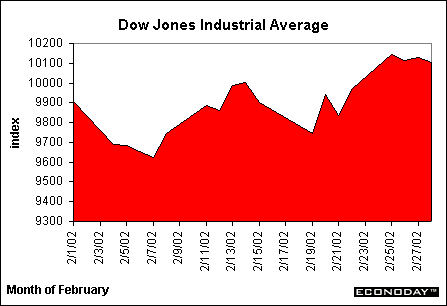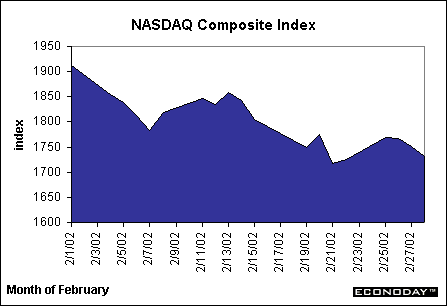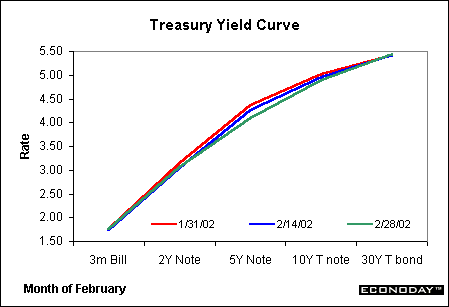Equities began the month of February with a slight decrease across indices that turned into a major decline.
With a combination of negative news and inconsistent earnings reports, equities faltered for much of the month.
Corporate accounting concerns in major corporations held stocks hostage for much of the month as the fall-out
from the Enron and Global Crossing situations continued. Some bright economic reports in the middle of the
month caused a rally, and the final week of February saw some more gains. Although financial markets are
being driven chiefly by economic news and earnings reports, Fed Chairman Greenspan dominated news in the
final week of February as his testimony to Congress indicated that a recovery is likely, although it will be slow.
Despite these attempts, only the Dow showed a gain for the month of February. The best news the markets
received during the month was a combination of economic reports, retail sales on the 14th of February, and
existing home sales on the 25th of February. This led to an end-of-month rally, although not enough to reverse
the negative monthly trend.

Earnings in technology and telecommunications stocks continued to flounder and send these sectors to major
losses for the month. Retailers continued to perform well in February. Discount retailers continue to lead the
retail sector, carrying retail stocks to consistent gains during the month. Energy stocks performed slightly better
in February after falling in January, although residual weakness still remains after the Enron-fiasco. Health care
and housing-related stocks were the best performers yet again. The financial sector also bounced back after
last month's negative performance. Travel and leisure stocks continue to decline as consumers have not
completely re-entered this sector of the economy. Transportation stocks in airline and automobile industries
declined for much of February even though consumers are spending money on new cars and are indeed taking
advantage of the discount fares.

Some days of the month were particularly strong, with the middle of February and the last week of the month
performing particularly well. Market players got the Dow to reach above the 10,000-point mark on February
14th, the day after a stronger-than-expected retail sales report. The index then fell off until the 25th of February,
when a report on existing home sales came in at a record number. The Dow then closed the month of February
consistently above the 10,000-point mark. For much of February, mixed corporate earnings grounded
investors, and pessimists still dictated the market's movement for much of the month. As mentioned earlier,
concerns over shady accounting practices in major corporations led to a feeling of pessimism in February. Fed
Chairman Greenspan testified before Congress covering the state of the economy on February 27th; it was a
long-awaited day for market players. Greenspan's comments were typically cautious, although he did say that a
recovery is in progress. The last trading sessions of the month recovered most of February's losses on the
Dow, but generally pessimistic investors kept other major indices from performing better. Days of decline
again outnumbered days of increases. The Dow closed the month with a 1.9 percent gain, while the NASDAQ
recorded a decline of 10.5 percent. The S&P 500 also decreased, finishing down 2.0 percent for February. The
Russell 2000 recorded a 2.8 percent loss, while the market encompassing Wilshire 5000 index decreased 2.2
percent in February.
| Date |
DJIA |
S&P 500 |
NASDAQ |
Russell 2000 |
Wilshire 5000 |
| 12/29/00 |
10788.75 |
1320.50 |
2471.37 |
483.54 |
12175.88 |
| 01/31/01 |
10877.36 |
1366.01 |
2772.89 |
508.34 |
12631.57 |
| 02/28/01 |
10493.33 |
1239.54 |
2151.51 |
474.11 |
11420.21 |
| 03/30/01 |
9875.60 |
1159.41 |
1839.63 |
450.12 |
10635.95 |
| 04/27/01 |
10734.64 |
1250.39 |
2116.47 |
485.71 |
11512.19 |
| 05/31/01 |
10990.41 |
1260.81 |
2149.44 |
501.52 |
11672.56 |
| 06/29/01 |
10503.75 |
1299.58 |
2169.31 |
510.30 |
11413.63 |
| 07/31/01 |
10522.8 |
1213.3 |
2027.1 |
484.5 |
11204.9 |
| 08/31/01 |
9949.8 |
1133.6 |
1805.4 |
468.6 |
10515.1 |
| 09/28/01 |
8847.1 |
1039.9 |
1498.6 |
404.2 |
9553.6 |
| 10/31/01 |
9075.8 |
1061.1 |
1690.2 |
428.2 |
9796.9 |
| 11/30/01 |
9851.6 |
1139.5 |
1930.8 |
453.7 |
10360.8 |
| 12/31/01 |
10021.6 |
1148.1 |
1950.9 |
488.5 |
10708.1 |
| 1/31/02 |
9920.0 |
1130.2 |
1933.9 |
483.1 |
10564.4 |
| 2/28/02 |
10106.1 |
1106.7 |
1731.5 |
469.4 |
10332.9 |
|
|
|
|
|
|
The Treasury Market
Slow roller
Treasuries were generally positive for most of the month, although there was not much movement in securities
until the end of February. Negative signs of the immediate future in equities continued to help Treasury
securities perform well as market players turn to quality risk-free investment when stocks perform poorly. The
big story in financial markets was continued accounting concerns in major corporations, and this kept investors
away from the stock market and helped Treasuries. Economic reports that affected securities this month were
actually few and far between, a change from the past few months. Even jobless claims volatility did not
negatively affect Treasuries, as this figure fluctuated between gains and losses for much of the month. The
employment situation released on the 1st of February was a positive indicator for Treasuries, while the
aforementioned surprises from retail sales and existing home sales also negatively affected Treasury-trading.
On February 27th brought Chairman Greenspan's testimony to Congress, which foresaw a long and slow
recovery, not the "V"-shaped recover equity investors are hoping for.
The Fed chairman's speech took bond investors by surprise, and helped cause a run on Treasuries. Market
players were happy that the Fed was not seeing a substantial recovery despite the fact Greenspan did
basically claim that the worst was over. The last day of the month saw an upward-revision to GDP, which also
negatively affected Treasury prices. Despite the end-of-month commotion, Treasuries generally performed
better for the whole month of February.

As can be seen in the chart above, yields were slightly down for the month of February. The mid-month figures
saw a slight downward trend in yields, a positive sign for Treasuries that continued through to the end of the
month. The general concern in equities helped push Treasuries up in February, and left yields down across
most of the yield curve. The 30-year bond was the lone poor performer, as that security saw a gain of 2 basis
points in its yield for February. The 10-year note fell 14 basis points, while the 5-year note outperformed the
other securities and declined by 28 basis points. The 2-year note fell 10 basis points, while the 3-month bill
showed very little movement for February, down just 1 basis point.
Damir Fonovich, Economist, Econoday
|
